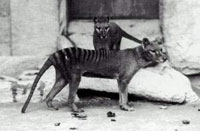
Most people in Australia would know of the Thylacinus cynocephalus, more commonly known as the Thylacine or the Tasmanian Tiger. For those of you that don’t know what the creature is let me give you a quick run down.
The Tasmanian Tiger is not a tiger at all, and despite its looks it isn’t a canine either. It was a marsupial predator that roamed Australia, and more recently, the small state in Australia, Tasmania. It bears a striking resemblance to a common dog and is defined by its tiger like stripes on its back towards its hind legs that continue down its long tail.
The last Tazzy Tiger died in 1936 in captivity.
Well, the ol’ taz tiger may be set to walk the forests of Australia once again with new advancements in cloning technology. Dr Andrew Pask and Professor Marilyn Renfree from the University of Melbourne have managed to insert a Thylacine gene into a mouse embryo. The gene used was the proα1(II) collagen (Col2a1) gene which controls the growth of bone and cartilage. The embryo continued to grow with the gene in place so that is definately good news for extinct species.
However, this doesn’t mean that the whole creature can be resurrected and there is still a lot more work to be done before that can be achieved. Even though it may never happen, damn its fun to think about. Dinosaur cloning is probably out of the question but if the technology is developed then you can be sure it will be possible to see Mammoths and other extinct mammals in reserves and parks (à la Jurassic Park). That would kick ass!
Check out these links.
The Research Article http://www.plosone.org/article/info%3Adoi%2F10.1371%2Fjournal.pone.0002240
http://en.wikipedia.org/wiki/Thylacine
http://www.abc.net.au/science/articles/2008/05/20/2249769.htm?site=science&topic=latest
